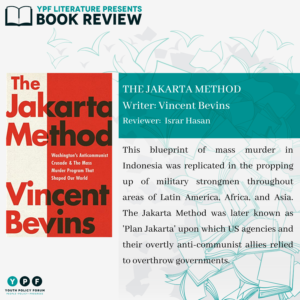My book review on Vincent Bevins’s amazing book, “The Jakarta Method” which speaks on how violence has been the vehicle in the remaking of our current “liberal world” order:
“In his monumental book, The Jakarta Method (Public Affairs Books, 2020), Bevins attempts to show how the violent homogenisation of much of the Third World carried out by the United States has come to define an era with ripple effects felt till this day. The book charts the violent trajectory of the anti-communist measures which led to seismic shifts in the polities of the countries, thus supplanting and relegating anti-communism to a position of questionable ideology.

The Jakarta Method, as its namesake suggests, starts in Indonesia, the world’s most populous Muslim-majority country and the leader of the Third World movement—a movement that looked to neither the US nor the Soviet Union to design its own socio-economic philosophy. Indonesia at that time consisted of a mix of communists, nationalists, and Islamists led by the charismatic Sukarno who coined his political philosophy as NASAKOM. Nasakom comprised Islam, communism, and nationalism. Indonesia had the largest communist party (PKI) in the non-communist world after its ruling Russian and Chinese counterparts. The PKI had three million card-carrying members and, according to Bevins, had support from a quarter of the rising nascent nation, which had made itself a starlet of the post-colonial world hosting the world-renowned Bandung conference. It was said to be the largest conference of coloured peoples across the world in 1955 and it challenged the status quo set by the twin polar opposite forces of Soviet communism and American capitalism.
Relying heavily on official declassified documents, research conducted with historians and other experts, and a plethora of testimonies from first hand sources, we see the unfolding and subsequent destruction of a nation in this book. Bevins uses stories of Indonesians and their diaspora communities to take us on the journey of a country whose tryst with destiny was sidelined by the constant interference of America. The archipelago had endured several bushfire wars of secession, failed assassination attempts on its leaders, bombings, and a smear campaign of President Sukarno in a Hollywood-made sex tape.
Sukarno had kept a delicate balance between his three pillars: communists, army, and the religious classes, primarily the Muslims. In what still remains shrouded in mystery, an obscure left-wing movement by the name of the ’30th September Movement’ assassinated the top generals of the armed forces in 1965, causing an orgy of bloodbath led by Suharto, the man who would rule Indonesia till the eve of the millennium. A million Indonesian leftists—communists, intellectuals, union organisers, and Sukarno supporters—fell victim to the army’s rage and their cluster of religious groups aided and abetted with the help of the United States, which had provided them with the hit list. It was with this massacre, Bevins argues, that the phrase “forced disappearances” and the Malay word “amok” first entered our lexicon. The world’s third largest communist party—democratic and unarmed—had been violently uprooted and remains banned till this day.
This blueprint of mass murder in Indonesia was replicated in the propping up of military strongmen throughout areas of Latin America, Africa, and Asia. The Jakarta Method was later known as ‘Plan Jakarta’ upon which US agencies and their overtly anti-communist allies relied to overthrow governments. A notable example is the marking of the homes of Chilean leftists with the word “Jakarta” and the Dirty War in Central and Latin America which played out in sync with the events of 1965.
Bevins’s narrative convincingly describes how the turmoil in Indonesia was not an isolated incident, but the biggest puzzle piece of the US’s anti-communism strategy in the Third World—all to make sure none of the newly independent countries fell into “Soviet communism”. Covering vast swathes of history, lands, cultures, and geography, Bevins spins a narrative very few of us know or have attempted to acknowledge. Communism still remains banned in Indonesia and with that, the hopes of reconciliation and reckoning with its past remains in disarray. With the rise of right-wing governments across the world, this book is a decisive and insightful look into the making and unmaking of nations and how the spectre of violent anti-communist crusades has left a blood-tainted mark on the world in its current state.”